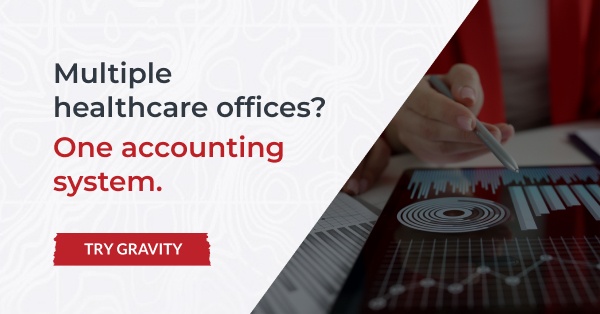7 trends redefining financial accounting in healthcare

The pace of innovation in healthcare has never been faster than it is today, and patient expectations have never been higher. Financial accounting in healthcare is also undergoing a significant transformation. Here are seven key trends likely to impact the way your finance team operates, especially if you manage a healthcare organization with multiple locations.
1. The rise of cloud computing in healthcare financial accounting
More than three-quarters of executives responding to a recent PwC survey said they had adopted the cloud in all or most parts of their businesses.
The survey found organizations powered by cloud-based technology are far more productive and profitable than those that lag behind. Within the healthcare industry, the widespread adoption of electronic health records (EHR) ensures every medical and billing professional has access to real-time information. For finance teams, cloud-based accounting solutions make it easier to centralize and automate invoicing, accounts payable and payment processing. They also improve transparency across the organization so everyone can see relevant details on inventory, purchase orders, or overall financial performance.
This has become critical for healthcare companies with many locations and shared expenses and vendors. The best cloud-based systems eliminate the need to enter a single shared expense in a dozen different databases, saving hours of time each week.
They also enable greater agility and flexibility for accounting teams still struggling with staffing shortages. With cloud-based systems, healthcare companies can meet employees' expectations for greater flexibility in the workplace while reducing the need for physical space and fixed assets.
The rise of cloud computing in healthcare financial accounting also underscores the need for greater cybersecurity. According to the 2023 IBM Security and Ponemon Institute's Cost of a Data Breach Report, 82% of data breaches occurred within cloud-based software. Healthcare companies can reduce their vulnerability to cyberattacks by adopting a zero-trust security model, requiring multi-factor authentication, and using the principles of least-privilege access. Educating employees at all levels on the necessity of keeping their passwords secure and avoiding phishing scams is also crucial, as stolen or compromised credentials and phishing were the top two causes of data breaches.
What you can do now:
- Evaluate third-party vendors’ security practices and ensure HIPAA compliance.
- Ensure cybersecurity with a zero-trust model, including multi-factor authentication.
- Assess the risks associated with a software or cloud services provider by viewing their SOC 1 and SOC 2 reports.
2. AI and machine learning in healthcare financial accounting
Cloud-based software has made it possible for healthcare organizations to process massive amounts of data, positioning them to take advantage of innovations in artificial intelligence (AI) and machine learning (ML), a subset of AI.
With the rise of wearable devices and technology-assisted diagnostics, AI is poised to revolutionize healthcare from a clinical standpoint. Healthcare financial accounting implications include the potential to forecast supply and demand, possibly better than the market can, to better allocate resources.
AI can transform the spaces where clinical work and financial concerns directly intersect. Predictive analytics and automation can assist clinical-side managers with scheduling nurses in a way that will make the most efficient use of staff, while advanced analytics and consumer segmentation can help drive patients to the least costly, most appropriate clinical setting, making the most efficient use of both human and facility resources.
In the revenue cycle, AI and machine learning can help identify fraud and improve financial reporting and analysis.
One of the most promising use cases is the potential to automate repetitive accounting processes like accounts payable. AP automation streamlines manual tasks like reading invoices and entering data. This can free up office administrators to have more meaningful interactions with patients, prioritize more strategic initiatives that can improve operations, and even reduce turnover by giving them more fulfillment in their roles.
What you can do now:
- Evaluate where AI and machine learning can save the most time and money in your workflows.
- Work with IT teams to implement AI-powered solutions to automate repetitive tasks.
3. Healthcare industry consolidation and its impact on financial accounting
After a lingering slowdown that lasted several years, healthcare M&A activity is picking up again, according to a report by Grant Thornton cited in Healthcare Executive.
Private equity investors are driving this shift, finding new opportunities to deliver more efficient, cost-effective care while adding new services. Physicians’ groups, dental offices, fertility clinics and other outpatient service providers that had been independent are becoming part of larger groups, creating opportunities to streamline everything from accounting and administration to technology platforms.
For healthcare administrators at companies that have recently been acquired, demonstrating greater efficiency and continual innovation is crucial.
What you can do now:
If your company is seeking an investment or a sale, it’s a good time to re-evaluate current processes and technology, especially if you have multiple locations using disparate solutions.
Work with your IT department to list each platform or application and identify any redundancies. You may need to consolidate systems to streamline financial reporting.
Consider the following questions to uncover long-standing frustrations and opportunities for improvement:
- Are you processing invoices for multiple locations through a single platform, or are you entering them into different systems based on location?
- Can you easily process payments from multiple providers?
- Can you easily allocate payments that apply to multiple locations?
- Do customers who receive regularly scheduled services (such as chiropractic care) have a secure payment portal where they can see what they owe and schedule recurring payments?
- Can you review and reconcile multiple transactions at the same time?
- Do you have a way to manage inventory across multiple locations?
- Are you spending hours each month logging in and out of different systems to create consolidated financial reports?
These questions may uncover inefficiencies and bottlenecks that are holding back your operations. Now is the time to address them and consider upgrading to a technology platform that can simplify and unify your processes—before new ownership or external forces push the need for change upon you.
4. Business intelligence for healthcare financial accounting
As healthcare companies look to achieve greater efficiencies following a merger or acquisition, we’re seeing a greater emphasis on business intelligence (BI) solutions.
Having accurate data on cash on hand and the ability to forecast how operational changes at specific locations will impact revenue projections across the entire organization increases your company's resilience, boosts stakeholders' confidence and drives decision-making toward future liquidity. Important insights pertaining to cash flow include inflow data such as revenue and operating income as well as cash outflow metrics such as operating expenses, which encompasses labor, leases, equipment, and administrative costs.
For healthcare companies with many locations, it's important to keep tabs on cash inflow and outflow metrics for the enterprise as a whole as well as each individual entity. This ensures a healthy overall revenue or operating income isn't just a few well-performing entities masking the underperformance of others.
Closely monitoring cash on hand also allows healthcare company executives to be prepared to take advantage of new acquisition opportunities or adjust to changes in demand.
What you can do now:
- Use accounting software with built-in business intelligence to track and visualize important metrics.
- Invest in BI tools that can consolidate financial data from multiple locations and entities, offering a unified view for improved decision-making.
5. Streamlining revenue cycle management in healthcare
If any part of the healthcare industry is ripe for redefinition, it's the revenue cycle, which includes managing claims processing, payment collections and patient billing. The numbers prove it: 42% of healthcare CEOs said if they stayed on their current paths, their businesses would be viable for only 10 more years.
The remedy for this, at least in part, is technology. According to a Becker's-PwC survey, 63% of respondents believe that leveraging new or existing technology would drive the most impact on the revenue cycle challenges they face.
This technology includes machine learning, AI, and automation. One promising development is AI-led automation that uses natural language processing to convert physician notes into billable codes, streamlining the claims process and potentially reducing the documentation burden on physicians—a major contributor to clinician burnout. AI can also identify and rectify billing errors, improving accuracy and reducing administrative overhead, as highlighted by PwC principal Anupriya Ramraj.
A critical area where technology can improve the revenue cycle is preventing claims denials. As Healthcare COO Melvin Miller wrote on the American Institute for Healthcare Compliance blog, "The ability to quickly identify denial issues, determine root causes, and develop solutions to reduce these denials through an iterative model that focuses on denial prevention is considered the key to addressing revenue cycle issues."
Billing staff can use past data to predict whether a claim will be rejected, while other available technologies can streamline the prior authorization process, which can help reduce denials before they even happen.
What you can do now:
- Automate manual processes such as billing reminders, invoice processing, and claims submission using AI-powered tools.
- Ensure your team is trained on systems that use optical character recognition (OCR) to read and process invoices. Be prepared for a learning curve as these systems need to be trained to recognize vendor names and formats.
- As AI solutions become more sophisticated, consider adopting technologies that can process invoices in different formats and improve accuracy and efficiency in billing.
6. Healthcare reform and financial accounting compliance
Since the Affordable Care Act, reforming the healthcare industry has taken on more prominence, both informally in terms of patient advocacy and formally with the passage of several pieces of healthcare-related legislation over the past decade and a half. Much of the legislation centers on two seemingly opposing themes: privacy and transparency. Healthcare companies must navigate between ensuring patients have greater access to information about their own health and the healthcare they seek while also preventing the misuse of patients' sensitive data.
Some recent healthcare regulations include:
- The No Surprises Act
The No Surprises Act bans most types of surprise medical billing, most specifically pertaining to charges for out-of-network care. In the words of the Centers for Medicare & Medicaid Services (CMS), "The No Surprises Act protects people covered under group and individual health plans from receiving surprise medical bills when they receive most emergency services, non-emergency services from out-of-network providers at in-network facilities, and services from out-of-network air ambulance service providers." It also puts protections into place for self-pay patients.
- Price transparency rules
Hospitals are now required to publicly post a machine-readable file containing several standard charges for all services provided by the hospital, as well as a consumer- friendly display of at least 300 "shoppable" services – that is, procedures that can be scheduled in advance. On the payer side, the Transparency in Coverage Act requires health plans and group insurance issuers to post in-network and out-of-network cost information for items and services along with an internet-based comparison tool providing consumers with cost-sharing information for 500 items and services.
- Cyber Incident Reporting for Critical Infrastructure Act
This legislation requires companies in designated industries, including healthcare, to report "substantial cyber incidents that are likely to result in demonstrable harm to the national security interests, foreign relations, or economy of the United States or to the public confidence, civil liberties, or public health and safety of the people of the United States, as determined by the Secretary of the Department of Homeland Security" to the Cybersecurity and Infrastructure Security Agency (CISA) within 72 hours after the incident.
These regulations are responses to technological advances, such as AI and the increased use of data. Patients are increasingly seeing themselves as consumers with the ability to shop around, demanding greater control over where they seek care and better access to their health information.
At the same time, legislators are responding to technological advances that could render patient health data more vulnerable to being accessed by malicious actors or for commercial purposes, as in the case of the FTC's warning to Amazon and One Medical against using patient health data to advertise other Amazon products. The agency also tasked the companies with making clear how their services will comply with HIPAA regulations.
What you can do now:
These regulatory changes require significant investment of time and resources by providers, payers, and adjacent businesses. To contend with this, companies can take the following steps:
- Leverage AI and robotic process automation (RPA) to free up revenue cycle staff and IT teams to fulfill new directives.
- Stay informed and continue to monitor evolving regulations, ensuring compliance while utilizing technology to streamline operations.
7. Emerging payment options in healthcare
In few places is the power of consumer demand to drive change in the healthcare industry more obvious than in the way care is paid for. Mobile payments, digital wallets, and blockchain technology are already changing the way consumers pay for services in other industries, and they are increasingly expecting these options in the healthcare sector.
Healthcare companies are taking heed of consumers' preferences, with 49% of provider executives who responded to a PwC survey citing customer experience as a top priority over the next five years. Those companies that fail to respond to calls for a better billing experience risk losing patients. RevSpring's 2023 Voice of the Patient Survey found that 56% of patients would likely switch providers after a poor billing experience. With the rise of retail providers, concierge providers, and other alternatives to traditional care models, that’s not an empty threat.
Offering patients a wider variety of bill pay options means accounting departments will need to work closely with IT departments to:
- Set up online payment portals.
- .
- Provide other digital infrastructure needed to meet patients’ billing preferences.
The tradeoff of this upfront work, however, is that offering more convenient payment options has the potential to reduce the burden on staff. Rectangle Health CEO Dominick Colabella told Forbes, "When patients are able to pay for their care using the method most convenient for them, they may be more likely to pay on time, saving staff from the need to send multiple bills, call with reminders, or otherwise chase down payments."
Digital payments also save practices from the need to wait for and manually enter checks.
"Decades in the healthcare space has also taught us that when providers don’t have to worry about the business side of healthcare, they are able to focus more on delivering the highest quality of care," Colabella said.
What you can do now:
- Offer multiple payment options, including the ability to log into a secure customer payment portal where patients can manage payments and view their payment history.
Gravity Software helps healthcare organizations stay ahead of the trends
With the increased presence of private equity in the healthcare market and economic volatility, we’re seeing a greater emphasis on using technology to improve efficiency, reduce costs, and provide a better patient experience.
Gravity is a multi-entity accounting software, perfect for healthcare systems, private equity firms with healthcare investments or multi-practice organizations.
Built on the Microsoft Power Platform, Gravity is uniquely positioned to leverage the latest advancements in automation and artificial intelligence, from making it easy to create automated approval workflows to using AI-powered invoicing to save hours each month.
Gravity uses Microsoft Power BI to consolidate multi-entity financial data, giving finance teams and investors real-time access to the insights they need to make smarter decisions.
Gravity Software is built on the Microsoft Power Platform, which adheres to Microsoft’s Security Development Lifecycle, ensuring compliance with HIPAA, SOC 2, and SOC 3 standards. With role-based security access, your team gains complete visibility into all activities, supported by a comprehensive audit trail. As a cloud-based solution, Gravity’s security features are automatically updated, keeping pace with the latest regulations and best practices. Additionally, Gravity provides both role-based and entity-based security access for detailed oversight of every transaction.
Learn more about how Gravity can transform your healthcare financial accounting. Schedule a demo today.
Gravity Software
Better. Smarter. Accounting.



